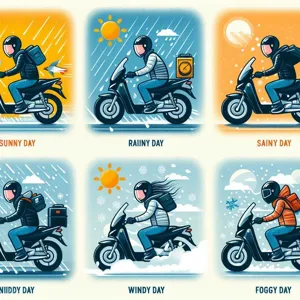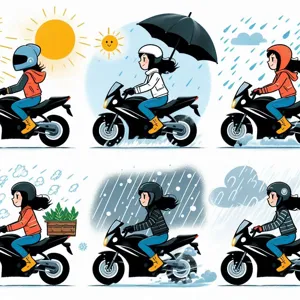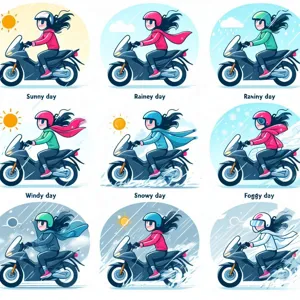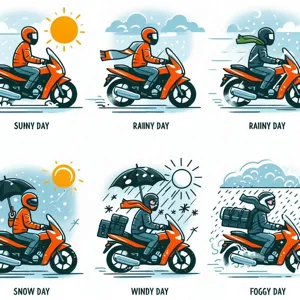For many motorbike enthusiasts, the thrill of the open road is an irresistible invitation, but when the skies darken and the weather takes a turn, that excitement can quickly transform into apprehension.
Riding a motorbike in varying weather conditions demands a unique set of skills and knowledge, from understanding how rain affects traction to effectively navigating the challenges of wind and temperature fluctuations. In this comprehensive guide, we will equip you with essential tips and techniques to master the elements, ensuring that you can confidently ride your motorbike in any weather. Whether you’re braving a drizzle, maneuvering through gusty winds, or tackling the chill of winter, preparing yourself and your bike for the unexpected will not only enhance your safety but also elevate your riding experience. Join us as we delve into the art of weather-ready riding, helping you embrace every journey, no matter the forecast!
1. Introduction: The Importance of Weather Awareness in Motorbiking

Riding a motorbike is an exhilarating experience that offers a unique sense of freedom and adventure. However, with that freedom comes the responsibility of being acutely aware of the weather conditions that can dramatically impact your ride. As a motorcyclist, understanding how various weather elements affect not only your bike’s performance but also your personal safety is crucial for an enjoyable journey.
Consider this: a sunny morning can quickly turn into a torrential downpour, and a light breeze may escalate into fierce winds without warning. Each of these weather changes can significantly alter the dynamics of your ride. Rain-soaked roads can become slippery, reducing traction and increasing stopping distances, while gusty winds can push you off course, demanding heightened focus and skill. Moreover, riding in extreme temperatures—be it sweltering heat or biting cold—can lead to fatigue and affect your judgment, making weather awareness paramount.
In this guide, we will delve into the various weather elements that every motorbiker should be mindful of, offering practical tips and strategies to navigate through rain, snow, wind, and heat. By mastering the nuances of riding in different weather conditions, you not only enhance your riding skills but also ensure your safety and the longevity of your motorbike. As the saying goes, “There’s no such thing as bad weather, only inappropriate clothing.” With the right knowledge and preparation, you can tackle any weather with confidence and keep the spirit of adventure alive on the open road. So, gear up and let’s embark on this journey to mastering the elements!
2. Preparing for Different Weather Conditions
Riding a motorbike offers a thrilling sense of freedom, but it also means facing the elements head-on. Preparing for different weather conditions is crucial to ensure not only your safety but also an enjoyable riding experience. Here’s how to gear up for whatever Mother Nature throws your way.
**Rainy Days:** When clouds darken and the rain begins to fall, it’s essential to have the right waterproof gear. Invest in high-quality rain suits, gloves, and boots that keep you dry and comfortable. Additionally, consider adding a pair of fog-resistant visors or goggles to your helmet to maintain visibility. During wet conditions, reduce your speed and increase your following distance, as stopping distances can significantly lengthen on slick surfaces. Familiarize yourself with how your motorbike handles in the rain, and practice smooth, gradual movements to avoid skids.
**Hot and Sunny Weather:** Riding in hot conditions can lead to fatigue and dehydration, so it’s vital to stay hydrated before and during your ride. Lightweight, breathable riding gear can help keep you cool while still offering protection. Make it a point to wear light-colored clothing that reflects sunlight rather than absorbs it. Don’t forget to apply sunscreen to exposed skin and consider wearing a full-face helmet with ventilation to allow airflow without compromising safety.
**Cold and Windy Conditions:** Riding in colder weather demands layering. Start with thermal base layers that wick moisture away from your skin, and then add insulating mid-layers. Top it off with a windproof and waterproof outer layer to guard against biting winds. Hand and foot warmth can be preserved with heated grips and thermal gloves and socks. As you ride, be extra cautious of icy patches on the road, especially in shaded areas or early in the morning.
**Foggy Conditions:** Fog can drastically reduce visibility, making it crucial to adapt your riding strategy. Use your bike’s low beam headlights and avoid high beams, which can reflect off the fog and impair your vision further. Slow down, maintain a safe distance from other vehicles, and be prepared for sudden stops. Consider using a helmet with an anti-fog visor or a pinlock insert to help maintain clear sight.
By preparing for these varying weather conditions, you equip yourself with the knowledge and gear necessary to handle the unexpected. Ultimately, understanding how to adapt to the elements not only enhances your riding experience but also ensures that you can confidently conquer the open road, no matter the weather.
3. Riding in Rain: Tips for Safety and Control

Riding in the rain can be a daunting experience for even the most seasoned motorcyclists, but with the right techniques and precautions, it can be managed safely and confidently. The key to mastering wet conditions lies in understanding how rain affects both your bike and your riding behavior.
First and foremost, ensure your motorcycle is equipped for the rain. Invest in high-quality tires that are designed to provide good grip on wet surfaces. Tires with deeper grooves are better at channeling water away, reducing the risk of hydroplaning. Additionally, check your brakes and lights; effective braking and visibility are paramount in poor weather conditions.
Once you’re on the road, remember that traction is your best friend. Rain can create a slippery surface, particularly in the first few minutes after it begins to fall, as oil and debris rise to the surface. To counteract this, approach corners with caution. Reduce your speed before entering a turn, and maintain a smooth line throughout. Sudden movements can destabilize your bike, so gentle inputs on the throttle, brakes, and handlebars are essential for maintaining control.
Visibility is another critical factor when riding in the rain. Ensure your helmet visor is clean and consider using an anti-fog treatment to prevent condensation. Bright, reflective gear is also advisable; it helps you stand out to other drivers, who may be struggling with their own visibility issues.
Lastly, be mindful of your following distance. Wet roads extend your stopping distance, so give yourself ample space between your motorcycle and the vehicle ahead. This buffer will allow you to react more effectively if the unexpected occurs—whether it’s a sudden stop or a need to navigate around a puddle.
By approaching rainy rides with respect and preparation, you can turn a potentially hazardous situation into an enjoyable adventure, all while enhancing your skills as a rider. Remember, every ride is an opportunity to master the elements—rain included!
4. Handling Windy Conditions: Techniques for Stability
Riding your motorbike in windy conditions can be a challenging experience, but mastering the techniques for stability can enhance both your safety and enjoyment on the road. As you navigate through gusty environments, it’s essential to adopt a proactive approach to maintain control and balance.
First and foremost, awareness is key. Before you even set out, check the weather forecast and be mindful of any wind warnings. If you find yourself in blustery conditions, keep your body relaxed and your grip firm on the handlebars. Tension can lead to jerky movements, making it harder to respond to sudden gusts. Instead, use your body to counter the wind—lean slightly into the direction of the wind to counteract its force. This subtle shift in weight can help you maintain your line and avoid being pushed off course.
Positioning on the road is another critical aspect. Try to ride in the center of your lane, where the surface is usually more stable and free from debris blown onto the edges. Additionally, be aware of large vehicles nearby, such as trucks or buses, as they can create turbulence when they pass. Ideally, maintain a safe distance from them, allowing you to ride more freely without being caught in their wake.
When making turns, be gentle and deliberate. High winds can catch your bike off balance, especially during sharp turns. Gradually lean into the turn, and avoid sudden throttle adjustments. Instead, maintain a steady speed and anticipate the wind’s movement, adjusting your lean angle as necessary.
Lastly, always wear appropriate gear designed for windy conditions. A well-fitted jacket with a windproof lining, along with sturdy gloves and a full-faced helmet, can help minimize the impact of the wind on your body, giving you more confidence and comfort while riding.
By implementing these techniques and staying mindful of your environment, you can conquer windy roads with poise and precision, ensuring your ride remains enjoyable no matter the weather.
5. Riding in Extreme Heat: Staying Cool and Hydrated

Riding a motorbike in extreme heat can be a challenging experience, but with the right strategies, you can stay cool and maintain your focus on the road. As temperatures soar, the sun’s relentless rays can sap your energy and increase the risk of dehydration, making it crucial to prepare adequately for hot weather conditions.
First and foremost, ensure you wear the right gear. Lightweight, breathable, and moisture-wicking fabrics can make a world of difference. Look for riding jackets and pants with ventilation panels that allow air to flow freely, helping to regulate your body temperature. While it may be tempting to ride in shorts and a t-shirt, protective gear is essential for your safety. Opt for lighter colors that reflect sunlight rather than absorbing it, keeping you cooler during long rides.
Hydration is another critical aspect of riding in extreme heat. Before you even swing your leg over the bike, drink plenty of water to start your ride off right. A hydration pack can be a convenient way to sip water as you ride, allowing you to maintain hydration levels without having to stop frequently. Remember, it’s easy to overlook your need for fluids when you’re focused on the road, but dehydration can lead to fatigue and impaired judgment, both of which can be dangerous while riding.
Take regular breaks to rest and cool down. Find shady spots or air-conditioned environments where you can take a moment to recharge. Not only does this give you the opportunity to hydrate, but it also helps prevent heat-related illnesses such as heat exhaustion or heat stroke. Pay attention to your body; if you start feeling lightheaded or excessively fatigued, it’s essential to pull over and rest until you’re feeling better.
Lastly, plan your route wisely. If possible, opt for roads with more tree cover or shaded areas to minimize your exposure to direct sunlight. Early morning or late afternoon rides can also help you avoid the peak heat of the day, allowing for a more comfortable experience.
By taking these precautions, you can enjoy the thrill of riding even in extreme heat, ensuring that your adventures remain safe and enjoyable no matter the weather conditions.
6. Cold Weather Riding: Gear and Safety Considerations
Riding in cold weather presents unique challenges that require keen awareness and proper preparation. As temperatures drop, so does the comfort and safety of your ride. It’s crucial to equip yourself with the right gear to combat the chill and maintain control of your motorbike.
Start with your base layer; investing in thermal undergarments can significantly enhance your comfort by trapping body heat. Look for materials designed for moisture-wicking to keep sweat at bay, as a damp layer can quickly lead to discomfort and cold. Next, consider your outerwear. A quality, insulated, and waterproof riding jacket is essential, offering both warmth and protection from the elements. Ensure it has adjustable cuffs and a high collar to seal in heat and block out wind.
Don’t underestimate the importance of your hands and feet. Insulated, waterproof gloves are a must to ensure that your fingers don’t become numb, which can impair your ability to operate the controls. Look for gloves with windproof linings and extended cuffs to overlap with your jacket sleeves. Similarly, choose insulated and waterproof riding boots to keep your feet warm and dry. Heated insoles can also be a game-changer for prolonged rides in frigid conditions.
Safety considerations in cold weather go beyond just wearing the right attire. Be mindful of the road conditions; cold weather can lead to frost, ice, and slippery surfaces, dramatically increasing the risk of accidents. Adjust your riding style by reducing your speed, maintaining greater distances from other vehicles, and being extra cautious during turns and stops.
Additionally, ensure that your bike is winter-ready. Check your tire pressure regularly as it can drop with the temperature, and opt for tires that perform well in cold and wet conditions. Keep your chain lubricated and inspect your brakes for optimal performance.
Lastly, don’t forget to stay hydrated and take breaks to warm up. Cold weather can be deceiving in terms of energy expenditure, and fatigue can creep in faster than you realize. By preparing adequately and staying vigilant, you can enjoy the thrill of cold weather riding while keeping safety at the forefront.
7. Snow and Ice: When NOT to Ride

Riding your motorbike in snow and icy conditions can be a thrilling yet perilous experience. While some seasoned riders might feel tempted to brave the elements, it’s crucial to recognize when it’s best to stay off the road. Snow and ice create treacherous conditions that can quickly turn a routine ride into a dangerous endeavor.
First and foremost, visibility becomes a significant concern. During snowfall, the flakes can obscure your vision, making it challenging to see the road ahead, not to mention other vehicles. Even if you have a powerful headlight, the swirling flakes can create an almost blinding effect, reducing your ability to react swiftly to obstacles. Moreover, icy patches can be deceptively hidden beneath a thin layer of snow, putting you at risk of losing control at any moment.
Additionally, traction is a critical factor when it comes to riding in winter conditions. Motorbikes are inherently less stable than cars, and when you add snow and ice into the mix, your chances of skidding or falling increase dramatically. Tires designed for summer or even all-season riding simply cannot provide the grip needed for icy roads. Even with winter tires, the risk remains high, especially on inclines or turns where the bike can easily slide out from under you.
It’s also important to consider the psychological aspect of riding in adverse weather. The stress of navigating slippery roads and the constant vigilance required can lead to fatigue, impairing your decision-making abilities. If your mind is preoccupied with the fear of falling or the need to overcompensate for a lack of grip, you are less likely to enjoy the ride or respond effectively to unexpected challenges.
In conclusion, while the allure of riding in the snow can be tempting — conjuring images of picturesque winter landscapes and a sense of freedom — it is crucial to be realistic about the risks involved. If the weather conditions are severe, it’s best to leave the bike in the garage and opt for safer modes of transportation. Remember, there’s no shame in waiting for clearer, safer days to hit the open road. Your safety should always be the top priority, and riding in icy conditions is simply not worth the risk. Stay smart, stay safe, and save the adventure for when the weather is on your side.
8. Understanding Road Conditions: Potholes, Flooding, and More
Riding a motorbike offers an exhilarating sense of freedom, but it also demands a keen awareness of road conditions, especially when faced with less-than-ideal weather. Understanding how to navigate potholes, flooding, and other environmental challenges can make the difference between a smooth ride and a dangerous situation.
### Potholes: The Hidden Menace
Potholes can be lurking beneath puddles or obscured by debris, making them particularly treacherous in rainy weather. When you encounter a pothole, it’s crucial to assess its size and depth quickly. If it’s shallow and you can safely ride over it, do so while maintaining a steady grip on the handlebars. For deeper potholes, if there’s an opportunity to maneuver around them safely, take it. Always remember to stay alert and keep your distance from vehicles ahead, as their sudden movements can signal the presence of road hazards.
### Flooding: Know When to Turn Back
Flooded roads pose significant risks for motorcyclists. Even a few inches of standing water can destabilize your bike or hide unseen hazards beneath the surface. Before attempting to ride through flooded areas, gauge the depth and the speed of the current. If you’re uncertain, it’s best to err on the side of caution and find an alternative route. Remember, the potential for losing control is high, and safety should always come first.
### Gravel and Debris: The Unseen Challenges
In addition to potholes and flooding, watch for debris on the road, especially after storms. Fallen branches, loose gravel, and mud can all create slippery surfaces that challenge your bike’s traction. When navigating these obstacles, slow down and shift your weight to maintain balance. Use your body as a counterbalance to keep the bike steady, and avoid sudden movements that could lead to a loss of control.
### Staying Informed
Before you hit the road, it’s beneficial to check local weather forecasts and road condition reports. Many regions have online resources or apps that provide real-time updates on roadblocks, flooding, and other hazards. Staying informed can help you make smarter choices about your route, ensuring a safer ride regardless of the weather.
By understanding and preparing for varying road conditions, you can enhance your riding experience and approach each journey with confidence. Mastering these elements will not only keep you safe but also allow you to enjoy the open road, rain or shine.
9. Maintenance Tips for Weather-Exposed Motorbikes
When it comes to riding your motorbike in various weather conditions, proper maintenance is your best friend. The elements can be unforgiving, with rain, snow, salt, and scorching sun all taking their toll on your machine. To ensure that your bike remains in peak condition, here are some essential maintenance tips for weather-exposed motorbikes.
**1. Regular Cleaning:** After each ride, especially in inclement weather, take the time to clean your bike thoroughly. This helps to remove dirt, grime, and salt, which can corrode metal parts and damage paintwork. Use a gentle cleanser specifically designed for motorcycles, along with a soft cloth or sponge to avoid scratches.
**2. Wax and Protect:** Applying a high-quality wax or sealant to your bike’s bodywork creates a protective barrier against moisture and UV rays. This will help maintain the paint’s shine and protect it from fading or oxidizing over time. Consider using products that offer hydrophobic properties to help repel water.
**3. Check Your Tires:** Weather can significantly impact tire performance, so it’s crucial to regularly check tire pressure and tread depth. Underinflated or worn tires can be hazardous, particularly in wet or icy conditions. Make it a habit to inspect your tires before every ride, ensuring they are safe and ready for the elements.
**4. Inspect Your Chain:** Exposure to rain and salt can lead to rust and corrosion on your bike’s chain. Regularly clean and lubricate your chain to prevent wear and tear. A well-maintained chain not only enhances performance but also contributes to a smoother ride.
**5. Battery Care:** Cold weather can be particularly harsh on your motorcycle battery. Keep an eye on its charge level, especially if you are storing your bike during the winter months. Investing in a smart battery maintainer can keep your battery topped up and in good condition, ensuring a reliable start every time.
**6. Protect Electrical Components:** Excess moisture can wreak havoc on your bike’s electrical system. Consider using dielectric grease on electrical connections to create a moisture-resistant seal. Additionally, inspect and clean connectors regularly to prevent corrosion.
**7. Store Smart:** If your bike is frequently exposed to the elements, consider investing in a high-quality motorcycle cover. This not only protects against rain and snow but also shields your bike from harsh sunlight, which can fade paint and damage plastics. If possible, store your bike in a garage or under a carport to minimize exposure.
By following these maintenance tips, you can effectively combat the effects of weather exposure on your motorbike. Proper care not only enhances performance but also prolongs the life of your beloved ride, allowing you to enjoy every journey, come rain or shine.
10. Choosing the Right Tires for Different Weather
Choosing the right tires for different weather conditions is one of the most critical aspects of ensuring a safe and enjoyable ride. Tires are the only contact point between your motorbike and the road, so selecting the appropriate type can significantly impact your handling, stability, and overall performance in varying weather conditions.
In dry and warm weather, you’ll want tires that provide excellent grip and responsiveness. Look for sport or touring tires designed for optimal traction on dry asphalt. These tires often feature a softer rubber compound that enhances grip, enabling you to take corners with confidence and acceleration without hesitation.
However, when the skies turn gray and the rain begins to fall, the dynamics change dramatically. Wet weather demands tires that excel in channeling water away from the contact patch to reduce the risk of hydroplaning. Tires with deeper grooves and a more aggressive tread pattern will help you maintain traction on slick surfaces. Opting for tires specifically designed for wet conditions can be a game-changer, as they often feature a rubber compound that remains pliable even in lower temperatures, enhancing grip.
As the temperature drops and winter conditions approach, special consideration must be given to the tires you choose. Cold weather requires tires that can withstand lower temperatures without losing performance. If you expect snow or icy roads, consider investing in winter tires specifically designed for cold weather riding. These tires typically have a more flexible rubber compound and a unique tread pattern that grips icy surfaces effectively.
It’s also important to regularly check the tire pressure, as fluctuations in temperature can lead to overinflation or underinflation, both of which can severely impact handling. Additionally, maintaining proper tread depth is crucial; worn tires lose their ability to grip and maneuver, putting you at greater risk during adverse conditions.
Ultimately, investing time in selecting the right tires for the weather will not only enhance your riding experience but also ensure your safety. Understanding how different tires perform in various conditions allows you to tackle any ride with confidence, no matter what Mother Nature throws your way.
11. The Role of Visibility: Riding in Fog and Low Light
When riding your motorbike in fog or low-light conditions, visibility becomes your number one priority. Fog can envelop the landscape in a thick, damp blanket, reducing your sight distance to just a few feet ahead. In these challenging conditions, it’s crucial to ensure that you are seen as much as you can see. This begins with your gear—opt for reflective clothing and accessories that catch the light and alert other road users to your presence. Investing in high-visibility vests, helmets, and gloves can make a significant difference, especially when navigating through the haze.
Your motorcycle’s lighting plays a vital role in enhancing visibility as well. Ensure your headlight is functioning optimally, and consider upgrading to brighter bulbs if you often ride in such conditions. Many riders also find that using their high beams can help illuminate more of the road, but be cautious not to blind oncoming traffic. Additionally, adding auxiliary lights can help expand your field of vision, allowing you to spot hazards lurking in the fog much earlier.
During foggy rides, reduce your speed and increase your following distance to allow for ample reaction time. The last thing you want is to be surprised by an unexpected obstacle or a sudden stop from the vehicle in front of you. Remember to also adjust your riding technique; smoother throttle and brake inputs will help maintain control and prevent skidding on slippery surfaces.
Lastly, keep your visor clean and free of condensation. The fog can create a veil of moisture on your helmet, impairing your vision even further. Anti-fog treatments can be a lifesaver in these situations, ensuring that your line of sight remains clear. By prioritizing visibility and taking the necessary precautions, you can confidently navigate through fog and low-light conditions, ensuring a safer ride no matter the weather.
12. Emergency Preparation: What to Do in Severe Weather
When it comes to riding a motorbike, preparation is not just about maintaining your bike or perfecting your riding technique; it’s also about being ready for whatever Mother Nature throws your way. Severe weather can strike unexpectedly, and knowing how to respond can mean the difference between a minor inconvenience and a serious hazard.
First and foremost, always monitor weather conditions before heading out. Use weather apps or local forecasts to stay informed about any impending storms, heavy rain, or icy conditions. If you find yourself unexpectedly caught in severe weather, the first step is to seek shelter. Look for gas stations, convenience stores, or any nearby buildings where you can wait out the worst of the storm. If there’s no immediate shelter, try to find a safe place off the road to park your bike and wait until conditions improve.
If you must continue riding in less than ideal conditions, adjust your speed and increase your following distance. Rain, wind, and reduced visibility require a more cautious approach. For heavy rain, consider using a rain suit to keep yourself dry and maintain warmth, as hypothermia can set in quickly. Additionally, using anti-fogging products for your visor will help you see clearly as moisture builds up.
In the event of high winds, be mindful of your bike’s stability; a firm grip on the handlebars and a relaxed posture can help you manage the bike more effectively. Remember to lean into the wind to maintain control and avoid being blown off course.
For those icy roads, the best decision is often to stay off the bike altogether until conditions improve. If you must ride, be gentle with your throttle and brakes to avoid losing traction. Look for alternative routes that may be less affected by ice, such as main roads that are more frequently treated.
Finally, ensure your motorcycle is equipped with emergency supplies. A basic first-aid kit, a flashlight, and a tool kit can be invaluable in case of an emergency. And don’t forget your mobile phone; a portable charger can keep your device powered up, allowing you to call for help if needed.
By preparing for severe weather and knowing how to respond effectively, you can enhance your safety and confidence, ensuring that your rides are enjoyable no matter the conditions. Remember, mastering the elements is not just about skill; it’s about preparation and awareness.
13. Mental Preparedness: Building Confidence in Challenging Conditions
When it comes to riding your motorbike in challenging weather conditions, mental preparedness is just as crucial as physical skills. Confidence is the cornerstone of a safe and enjoyable ride, especially when facing the unpredictable elements. To build this confidence, start by familiarizing yourself with the unique challenges that different weather conditions present. Whether it’s the slick roads of a rainy day, the blinding glare of the sun, or the biting chill of winter winds, understanding how each factor affects your ride is the first step toward mastering your mindset.
Visualization techniques can be particularly beneficial in this regard. Before you set out on your journey, take a moment to mentally walk through the ride. Picture yourself navigating through the rain, maneuvering around puddles, and responding calmly to unexpected obstacles. Envisioning these scenarios can prepare your mind for the realities of the road, reducing anxiety and instilling a sense of control.
Another essential aspect of mental preparedness is acknowledging your limits. Every rider has different comfort levels and experiences; it’s vital to recognize when the conditions may be beyond your skill set. If you feel uneasy about riding in heavy rain or strong winds, don’t hesitate to postpone your ride. Building confidence doesn’t mean pushing yourself into uncomfortable situations; it involves knowing when to take a step back and assess the risks.
Practice is key to building confidence, too. If possible, seek out controlled environments where you can experience various weather conditions without the pressure of traffic. Many riding schools offer courses that simulate adverse weather scenarios, allowing you to hone your skills and develop a sense of security on your bike.
Lastly, never underestimate the power of a positive mindset. Surround yourself with fellow riders who share your passion for mastering the elements. Sharing experiences and tips can bolster your confidence and reinforce the idea that you’re not alone in facing the challenges of riding in all weather conditions. Remember, confidence is built over time; each ride, regardless of the weather, is an opportunity to learn and grow as a motorcyclist. Embrace the journey, face the elements head-on, and watch your confidence soar.
14. Real-Life Experiences: Stories from Veteran Riders
When it comes to mastering the elements while riding a motorbike, there’s no substitute for real-life experiences shared by those who’ve faced the unpredictable whims of Mother Nature. Veteran riders possess a treasure trove of stories that not only entertain but also impart invaluable lessons about navigating inclement weather and challenging conditions.
Take, for instance, the account of Lisa, a seasoned rider who embarked on a cross-country journey during a summer storm. As dark clouds rolled in and the rain began to pour, she recalled the moment the skies opened up. “I remember feeling the first drops hitting my jacket and thinking, ‘This isn’t going to end well.’ But instead of panicking, I slowed down, kept my distance from other vehicles, and focused on maintaining control.” Her experience serves as a reminder of the importance of adapting riding techniques in response to changing conditions.
Then there’s Tom, who once faced a sudden hailstorm while riding through the mountains. He vividly describes the sensation of the icy pellets striking his helmet and the immediate instinct to find shelter. “It was a lesson in preparedness. I learned to always have a plan for unexpected weather, whether that means knowing where to find cover or having the right gear on hand.” His story underscores the necessity of being proactive rather than reactive when it comes to weather-related challenges.
These anecdotes not only highlight the unpredictability of weather conditions but also showcase the resilience and adaptability that come with experience. Each story is a testament to the camaraderie among riders and the wisdom gained from facing the elements head-on. By learning from these veterans, new riders can develop a deeper understanding of the importance of preparation, respect for the roads, and the courage to push through adversity, ensuring every ride is not just safe but also memorable. As you delve into the world of motorcycling, remember: every seasoned rider has weathered a storm, and their experiences can guide you in mastering the elements on your own journeys.
15. Conclusion: Embracing the Elements for a Thrilling Ride
As we reach the conclusion of our journey through the myriad challenges and exhilarating experiences that weather can bring to motorbike riding, it’s essential to embrace the elements as part of your adventure rather than as mere obstacles. Riding in varying weather conditions—from the warmth of a sunny day to the chill of a rainy afternoon—offers a unique opportunity to connect with your bike and the open road in ways that clear skies simply can’t provide.
Adapting your riding style to suit the elements not only enhances your skills but also deepens your appreciation for the thrill of the ride. Each drop of rain, gust of wind, or ray of sunshine can transform the landscape around you, unveiling a fresh perspective on familiar routes. Remember, preparation is key; the right gear—whether it’s waterproof clothing, thermal layers, or high-visibility accessories—can make all the difference in ensuring your comfort and safety.
Moreover, understanding how weather affects road conditions can empower you to make informed decisions on the fly, allowing you to experience the rush of riding with confidence. Whether it’s navigating through puddles, adjusting your speed on slick surfaces, or braving the chill of a brisk morning ride, learning to thrive amidst the elements will elevate your motorcycling experience to new heights.
So, as you rev up your engine and head out into the world, remember that every ride is an opportunity to embrace the elements. With the right mindset and preparation, you can transform potentially daunting weather challenges into thrilling experiences that leave you invigorated and eager for more. The open road awaits—whatever the forecast!
As we wrap up our complete guide to mastering the elements while riding your motorbike, remember that the key to a successful ride in any weather lies in preparation, adaptability, and a deep understanding of your machine. Whether you’re braving the rain, tackling the heat, or navigating icy roads, the tips and strategies outlined in this post will empower you to ride confidently and safely, no matter the conditions. Embrace the challenges that different weather brings, and let them enhance your skills and enjoyment of motorcycling. So gear up, stay informed, and hit the road with the assurance that you can take on whatever Mother Nature throws your way. Happy riding, and may your adventures be thrilling and safe!






